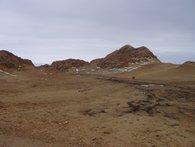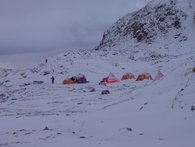From single pioneers to complex communities: Simultaneous discrimination of composition and inferring species inter-actions of fossil as well as modern pro- and eukaryotic microbial communities
Funding: German Research Foundation DFG
Status: current
Cooperations:
Prof. Dr. Thomas Friedl, Universität Göttingen





The Goal of the project is an understanding of the development of microbial communities in soil, from the initial assembly to complex networks. Microorganisms critically impact the development of soils in extreme environments. Soil microbes react with strong shifts in their community structures on environmental changes, e.g. nutrient increase or temperature raise.
Antarctic soils are fragile ecosystems due to their low nutrient content; they are seen to provide very good early indications of environmental change. Our central working hypothesis includes that prokaryotic microorganisms are the key players in the initial assembly succeeding in a complex network of the various pro- and eukaryotic microorganisms which based on different functions within the network is responsible for the further development and, finally, the stabilization of the soil habitat.
Eukaryotic algae may interact as pioneers already in the early stages of soil development given the bioavailability of nitrogen sources. To test the hypotheses the project will link the expertise of Göttingen University and GFZ Potsdam. We will utilize already available samples collected at five transects in the forefields of glacier remains in ice-free oases at Larsemann Hills, Prydz Bay, East Antarctica. A thorough analysis of key physicochemical parameters of the soil samples is crucial to relate microbial diversity to geochemical variables. Given the extreme oligotrophic environment and remoteness of the study sites we expect to recover a considerable number of well adapted so far unknown species, representing a valuable source for potential biotechnological applications.
We extend the space-for-time substitution approach of chronosequences to the microscale of comparisons between extracellular and intracellular DNA of microrganisms. Performing of a novel DNA extraction protocol will enable a precise distinction between extinct (fossil) and recent live microbial communities. Both DNA pools will serve the taxonomic assessment of microbial communities at the level of species. Finally, through deep sequencing (Illumina MiSeq) of amplicons from two complementary and differently variable rRNA gene signatures resolution at the species level will be accomplished. This is essential to infer those species interactions at high precision which facilitate the development of early soil ecosystems, i.e. within microbial associations across kingdoms and domains, e.g. between eukaryotic algae and bacteria.
Analyses of functional genes will assess structure and functional relationships between pro- and eukaryotic microbial communities in nutrient fluxes of carbon and nitrogen. Finally, after estimating the relative abundances of the distinct microbial and functional groups using quantitative qPCR those species interactions can be inferred which act on the microbial production.


